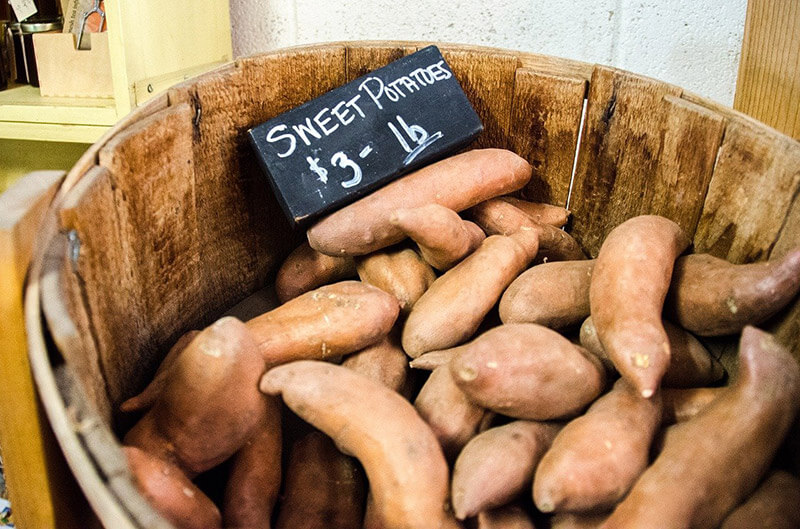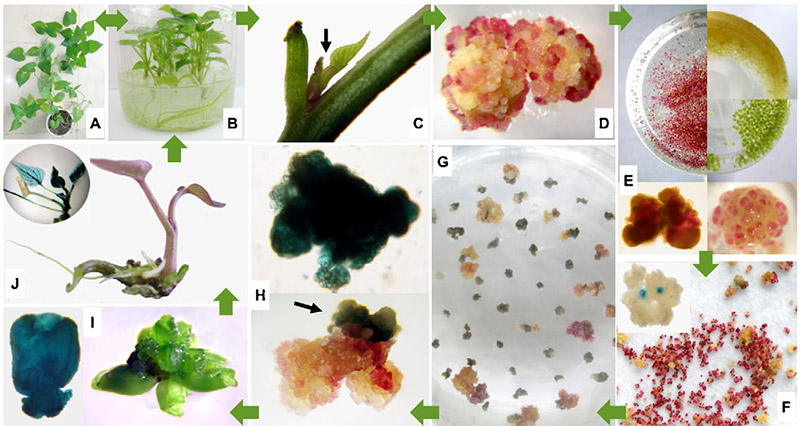Dioscorea esculenta (Lour.) Burkill, also known as sweet potato, is a dicotyledonous plant that belongs to the bindweed or morning glory family, Convolvulaceae. Sweet potato is rich in nutrients, starch, sugars, protein, vitamins, cellulose and various amino acids. Sweet potatoes are weakly alkaline, while rice, noodles and meat are acidic foods, so eating sweet potatoes in moderation can maintain the acid-base balance in the blood. In recent years, it becomes a hotspot to get Dioscorea esculenta (Lour.) Burkill with strong disease resistance, insect resistance, herbicide resistance, salt tolerance, cold tolerance, storage tolerance, tuber flavor, anthocyanin yield, etc.

Lifeasible provides one-stop services, including experimental design, vector construction, plasmid transformation, positive transplant screening and characterization of transgenic Dioscorea esculenta (Lour.) Burkill. We offer Dioscorea esculenta (Lour.) Burkill transformation using various genetic engineering technologies as follows:
Through the quantitative overexpression of genes related to lycopene, anthocyanin, malic acid and other chemical components in Dioscorea esculenta (Lour.) Burkill, the production of specific compounds can be increased. We could help you overexpress many genes like ERECTA gene that regulates physiological functions including plant growth and microbial stress response, StDRM2 gene that affects DNA methylation and then affects plant growth and development, StMKK1 which affects signal transduction and corresponding to stress, the heat shock transcription factor gene HsfA3 that affects the response of potato to heat stress, StLTP10 gene which regulating potato resistance to late blight, and many other genes related to important traits of Dioscorea esculenta (Lour.) Burkill.
RNAi technology is widely used in the field of gene modification, it refers to the phenomenon of highly conserved, induced by double-stranded RNA (dsRNA), homologous mRNA high-efficiency and specific degradation in the evolutionary process. Through RNAi technology, the silencing of multiple genes in Dioscorea esculenta (Lour.) Burkill can be mediated.
Virus induced gene silencing (VIGS) means that after viruses carrying target gene fragments infect plants, they can induce plant endogenous gene silencing and cause phenotypic changes, and then study the function of target genes based on phenotypic variation. Because the VIGS technology is a method of transient transformation, So silencing the target genes in Dioscorea esculenta (Lour.) Burkill through VIGS can help you achieve valuable information for gene functional analysis in a short time. With wealth of experience in VIGS, the scientists in Lifeasible provides you customized protocol for VIGS in Dioscorea esculenta (Lour.) Burkill. We could achieve the transformation for Dioscorea esculenta (Lour.) Burkill with different genetic backgrounds.
The discovery of the CRISPR/Cas9 system provides us with a very powerful and convenient gene editing tool. By using CRISPR technology, we can knockout Dioscorea esculenta (Lour.) Burkill genes in different ways, including frameshift mutations, multiple deletion of fragments, knockout of non-coding genes, knockout of multiple copies of genes, etc.
The strong scalability of CRISPR system can be used to develop more useful gene editing tools. we have developed many methods that can improve gene knock-in efficiency and achieve precise editing of the Dioscorea esculenta (Lour.) Burkill genome. For the gene knock-in process, most of CRISPR gene knock-in is done through HDR. Therefore, we have developed different methods to increase the probability of HDR, thereby improving the efficiency of gene knock-in.
CRISPR Single base editing technology is a hot area of life science research today. As a company that has been cultivating gene editing technology for decades, Lifeasible cougld help you achieve the conversion from C to T or A to G in Dioscorea esculenta (Lour.) Burkill using CBE and ABE, both of which rely on the DNA positioning capabilities of the CRISPR/Cas9 system. During single base editing, the C base deaminase or A base deaminase is located at a specific position in the genome, and it catalyzes the deamination reaction of C or A at a specific position and turns it into U or I. Then it is treated as T or G in the process of DNA replication, realizing the conversion from C to T or A to G.As a variant of CAS protein after domain inactivation, dCAS9 still retains the ability to recognize and bind to specific DNA sequences, so it can derive many important functions. One of them is CRISPR interference, which can be used to inhibit gene expression. For the inhibition of Dioscorea esculenta (Lour.) Burkill genes, we can provide a variety of solutions, including dCas9 binding to targeted DNA and realizing Inhibition of gene transcription through steric hindrance. In addition, gene knockdown can also be achieved by recruiting a fusion protein to the start site of gene transcription.
CRISPRa technology uses the powerful capabilities of Cas9 and sgRNA to fuse or recruit multiple proteins to enhance gene transcription. For Dioscorea esculenta (Lour.) Burkill genes, we provide VPR technology, SAM technology and Suntag technology to allow the CRISPR system to carry more activation element and achieve a stronger activation effect after synergistic amplification.
The study of gene function has always been the core subject of biological research. Lifeasible offers well-established platform of the reverse genetic screening system based on CRISPR technology, which can help you complete mutation library construction work at a very low-cost. The gene mutation library construction technology we provide for Dioscorea esculenta (Lour.) Burkill including gene knockout library construction, gene knockdown library construction, and gene activation library construction. Moreover, single-cell sequencing is available for mutation screening.
DNA-free gene editing technology has received extensive attention from the industry in recent years. We provide DNA free Dioscorea esculenta (Lour.) Burkill genome editing services, including transient expression of CRISPR/Cas9 plasmid DNA, in vitro transcription of CRISPR/Cas9, and pre-assembled ribonucleic acid composed of purified Cas9 protein and sgRNAs complex. These technologies can avoid the integration of foreign DNA and genome, and reduce off-target effects. In addition, compared with traditional techniques, these techniques can avoid the use of hybridization or backcrossing to isolate CRISPR/Cas9 chimeras, so they are cheaper and have shorter experimental cycles.
Genetic Transformation Process for Dioscorea esculenta (Lour.) Burkill
So far, the most advanced and widely used method for the development of genetically modified Dioscorea esculenta (Lour.) Burkill is Agrobacterium-mediated transformation. Briefly, the foreign target gene is transferred and integrated into plant cells through shoot organogenesis from explants infected by Agrobacterium, and then transformed plants are regenerated through techniques such as tissue culture, the specific operation process is shown in the figure below.
 Figure 1. Schematic illustration of Dioscorea esculenta (Lour.) Burkill transformation system. (A) plant in pot, (B) in vitro shoot culture, (C) shoot organogenesis from explants infected by Agrobacterium, (D) embryogenic callus, (E) suspension cultures of different cultivars (upper panel) and embryogenic clusters (lower panel), (F) embryogenic calli in co-cultivation and transient GUS assay (upper left corner), (G) selection of hygromycin-resistant calli on regeneration medium, (H) development of hygromycin resistant callus from arrow-indicated mother tissue (bottom) and GUS positive callus (up), (I) mature somatic embryos from hygromycin resistant calli (right) and GUS positive somatic embryos (left), (J) transgenic plantlets germinated from somatic embryos and GUS expression in shoot (upper left corner). (Jun Y, et al. 2011)
Figure 1. Schematic illustration of Dioscorea esculenta (Lour.) Burkill transformation system. (A) plant in pot, (B) in vitro shoot culture, (C) shoot organogenesis from explants infected by Agrobacterium, (D) embryogenic callus, (E) suspension cultures of different cultivars (upper panel) and embryogenic clusters (lower panel), (F) embryogenic calli in co-cultivation and transient GUS assay (upper left corner), (G) selection of hygromycin-resistant calli on regeneration medium, (H) development of hygromycin resistant callus from arrow-indicated mother tissue (bottom) and GUS positive callus (up), (I) mature somatic embryos from hygromycin resistant calli (right) and GUS positive somatic embryos (left), (J) transgenic plantlets germinated from somatic embryos and GUS expression in shoot (upper left corner). (Jun Y, et al. 2011)
Lifeasible offers our customers with professional one-stop services, covering all steps including experimental design, vector construction, plasmid transformation, positive transplant screening and testing. We provide multiple options for multiple Agrobacterium strains (LBA288, NCPPB2695, GV3101, AG63, AGL-1, EHA105, and C58C1), as well as commercial and customized binary vectors with variant selectable markers (Kanamycin, Hygromycin, Phosphinothricin, G418, etc.), which could adapt to diverse purposes of different customers. Experts at Lifeasible obtain comprehensive knowledge and years of experience to solve technical problems and challenges in Dioscorea esculenta (Lour.) Burkill transformation. We can draw customized solution to help you research the function of a variety of Dioscorea esculenta (Lour.) Burkill genes (Including ERECTA gene that regulates physiological functions including plant growth and microbial stress response, StDRM2 gene that affects DNA methylation and then affects plant growth and development, StMKK1 which affects signal transduction and corresponding to stress. The heat shock transcription factor gene HsfA3 that affects the response of potato to heat stress, StLTP10 gene which regulating potato resistance to late blight, etc.), Our services guarantee the success of your project. For more information or any inquiry requirements, please contact Lifeasible.
Reference